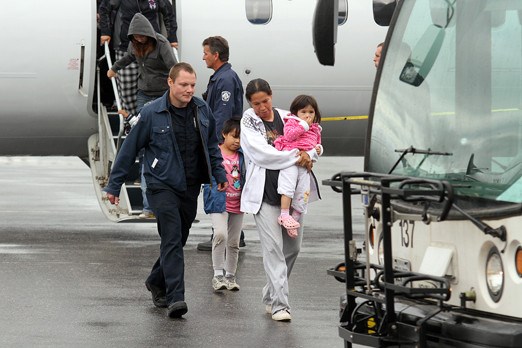Sandy Lake First Nation has faced forest fires before but the chief of the community says they have learned from that experience and are prepared to handle this year’s blazes.
Around 230 residents of the First Nation community evacuated to Thunder Bay on Sunday and Monday, with Chief Bart Meekis suggest those most susceptible to smoke, such as the elderly and those with medical problems, be evacuated to safety.
Meekis said ultimately about 550 people could be escorted to the city if conditions don't improve.
Forest fires are ravaging the wilderness near the Manitoba border with most of the smoke billowing toward the community.
Meekis said the the most recent evacuation is considered Phase 1, adding and added plans aren't in place for a full-scale evacuation, which would be Phase 2.
Last year’s fires were a real learning curve, Meekis said, noting as of Monday the nearest blaze is about 16 kilometres away.
“We’re not concerned with fires approaching the community, just smoke that’s why this is Phase 1,” Meekis told Tbnewswatch.com in a phone interview.
“I don’t think there will be a Phase 2 for a while. The fire isn’t approaching so there’s less panic and we’re more prepared. We know what to do or at least partly what to do. The elders know what to do and the community better than last year.”
Meekis added most of the fires have stayed around 20 to 30 kilometres away from the community.
Thunder Bay Fire and Rescue Services deputy chief Greg Hankkio said Monday that they will continue to meet evacuees at the airport and offer transportation for when they arrive.
"We're using city buses right now,” Hankkio said. “Then we bring them to the location they're staying at. Then we make sure they've got some food available to them immediately and water.”
“We register them all and do a medical assessment on them. We have some nurses on site there and they're working in co-operation with the Red Cross."
So far the transition has been a smooth one, Hankkio said.
"Yesterday went very well," he said. "With the exception of the torrential downpour we experienced while we were trying to transfer our visitors from the plane to the bus. But things went quite well. We've got a bunch of great partners working with us, and some of the other agencies," he said.
"We've done this multiple times in the past, so we're getting better at it as we go along. Like any emergency, we debrief after the previous one and try to make improvements as we go to make it more efficient and more effective ... We anticipate they'll go as smoothly as possible again today."
While the fires themselves aren't directly threatening Sandy Lake First Nation at this time, and wet weather throughout Northwestern Ontario is expected to stop them from spreading as rapidly as they have been, Hankkio said Sunday as a precaution they were evacuating the most vulnerable members of the community, with thick smoke drifting into the Sandy Lake area.
According to the Ministry of Natural Resources, there are 66 active fires burning in Northwestern Ontario. It's not enough of a concern to warrant a full-scale evacuation, however.
“It’s the people that are most severely impacted by the smoke so some of them are elderly, we have some infants,” Hankkio said, noting they will be working alongside several agencies, including community liaisons, Aboriginal Affairs and Northern Development Canada.
"We're just going to try to make them as comfortable as we can while they're here visiting us."
Thunder Bay Mayor Keith Hobbs has signed an emergency declaration for Thunder Bay in support of the effort. Hobbs said he didn't think twice about offering a helping hand.
"Chief (Bart) Meekis contacted me personally and asked if Thunder Bay could be the host community for his people," Hobbs said, reached via email. "Last year Sandy Lake residents resided here after being evacuated and consider Thunder Bay a safe haven. There is an agreement in place with AANDC for full cost recovery and there is an economic benefit to the city as well. Two local hotels will be full and other businesses will benefit with dollars spent.
"More important, though, is that this is a humanitarian effort and Thunder Bay is famous for assisting people in need as was evident last year during the forest fires and also the recent flood."
Hobbs added that some accomidations have been made for residents to stay at the Travelodge Hotel.
Five plane-loads of evacuees are expected to arrive in Thunder Bay on Monday. Hankkio on Sunday said the city will play it by ear from there.
“Like with any emergency situation and typically forest fires the smoke is fairly dynamic, just based on the wind,” he said.
Thunder Bay hosted 350 evacuees last year and served as a transportation hub for hundreds more from several threatened First Nations.
